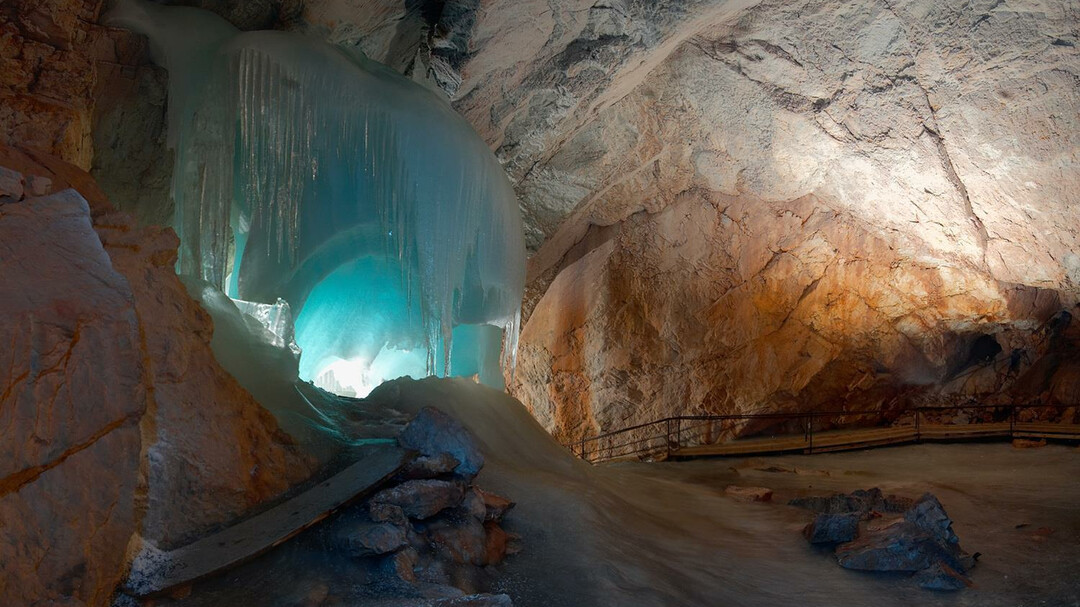Cave of the Crystals, Mexico:
Largest natural crystals in the world can be found in the Cueva de los Cristales. But there are hazards associated with this glittering location. Visitors are only allowed to remain in the cave for ten minutes at a time because to the extreme heat, which can reach 58 degrees Celsius (136 degrees Fahrenheit). You also need to tread extremely carefully because the tiniest crystals are razor-sharp.
Reed Flute Cave, China:
Among the world's largest caves is this one. Numerous stalactites and stalagmites are displayed by a system of artificially coloured lights, which gives the interior a surreal glow. The reeds that grow at the cave's entrance give it its name since they can be used to build flutes. Within the cave, inscriptions from 792 CE have been discovered.
Fingal’s Cave, Scotland:

This cave's amazing geometric structure appears too good to be true, but it's really genuine. Lava crystallized into the hexagon-shaped columns that are the cave's most well-known feature when it was exposed to air and water. The dome-shaped ceiling of the cave, which is situated on the deserted Scottish island of Staffa, naturally magnifies the sound of the waves, giving them an eerie quality.
Batu Caves, Malaysia:
Among the most visited Tamil temples outside of India are the Batu Caves. The location draws millions of pilgrims annually who flock to the caves—many of which have been converted into temples—to celebrate the Thaipusam holiday. A golden statue of the god Murugan, standing 40 meters (131 feet) tall, guards the entryway, which is approached by a staircase with 272 steps!
Waitomo Caves, New Zealand:
The glow-worm phenomenon, which has existed for more than 30 million years, was only discovered about a century ago and is now a popular tourist attraction. The number of glow worms in these bioluminescent tunnels makes them more impressive. Thousands of sparkling particles combine to create the appearance of being in the Milky Way. The glowworms cling to the cave walls with silk threads and use a blinding blue light to attract their prey. Despite this, the amount of glow worms in these bioluminescent caverns sets them apart. The thousands of shimmering particles give visitors the sensation they are in the Milky Way. The glowworms use silk threads to cling to the cave walls, enticing their prey with a brilliant blue light. The glow-worm phenomenon, which began only a century ago and is now a major tourist attraction, began to appear at this almost 30-million-year-old natural location.
Carlsbad Caverns, USA:
These amazing caves in New Mexico are estimated to be four to six million years old, the consequence of sulfur-rich gas seeping into the reef and dissolving the limestone. The caverns' incredible appearance is due to large concentrations of gypsum, clay, and lime.
Eisriesenwelt Ice Cave, Austria:

Only at the close of the 1800s was this magnificent ice cave—whose name translates to "World of the Ice Giants" in German—discovered. It is the world's largest ice cave, spanning over 42 km (26 miles). Because of the shifting climate, its internal structure is always changing, but it is nevertheless breathtaking.
Font-de-Gaume, France:
The commune of Les Eyzies-de-Tayac-Sireuil, in the French department of Dordogne, is home to the Font-de-Gaume cave. More than two hundred paintings and engravings from the Magdalenian era hang on its walls. An excellent method of learning about life in the (really) past!
Cango Caves, South Africa:
It is simple to envisage people living in these caverns throughout the Mesolithic and Neolithic periods due to their enormous "rooms" and striking shapes. Situated in the Western Cape Province, the location draws a sizable number of visitors annually. Just around 25% of the cavern network, which spans more than 4 km (2.5 miles), is accessible to visitors.
The Marble Cathedral, Chile:
There's no doubt about it—this cavern network in General Carrera Lake is the most beautiful in the world! The site, which was formed by calcium carbonate mineral formations, was designated as a national monument in 1994, and it's understandable why! From a small boat, one may see the complete network of caves while the tide is out.
Insanely Beautiful Caves:

These underground locations look almost too gorgeous to be real, whether they are ice-covered, vibrantly coloured, or revered areas. If you're not frightened to descend into the Earth's depths, check out these 25 amazing caves and caverns!
Ice Cave in Mutnovsky Volcano, Russia:
Within a volcano, an ice cave? That is, quite surprisingly, what occurs in Russia when the natural world goes crazy. After a period of intense snowfall, which formed this ice tunnel, this cave emerged. When light filters through the walls of this 300-meter (984-foot) cave, it creates a rainbow of colours.

.jpg)